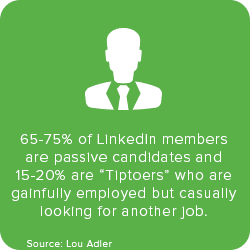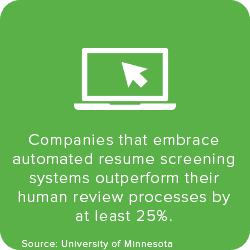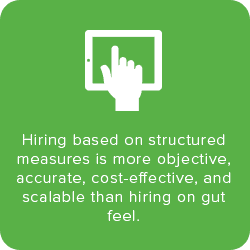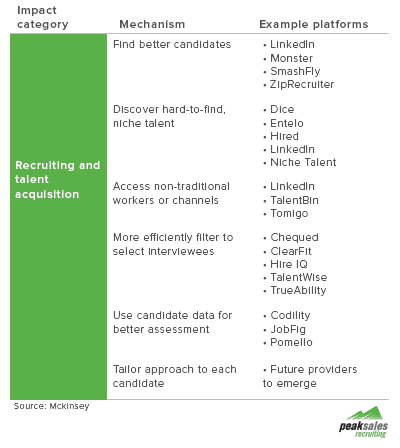
Technology and data analytics are a critical advantage for human resource leaders that are committed to building and maintaining a high performance sales force.
Recruiting A-players, the most important sales force effectiveness driver, is quickly moving up the priority list for sales leaders – 41% express dissatisfaction with their current sales force, saying they weren’t able to effectively sell value. Yet with strong indicators that US and global marketplaces will be healthy in 2017 and beyond, corporate leaders have set aggressive sales and growth targets. This has put increased pressure on Heads of Sales to critically evaluate resources — specifically human capital resources — that are vital to making the number and advancing the organization. With more than 40% of employers reporting talent shortages in 2017 (revealing a 10% increase since 2010), and Baby Boomer retirement contributing to a declining population of proven salespeople, human resources (HR) is being counted on to fill the sales force with top talent.
Companies that embrace new technologies to support recruiting and other critical HR responsibilities will find a better breed of salesperson, improve diversity, and reduce hiring costs.
In this article we’ll look at how technology, such as data analytics, professional networking sites, and hiring software, are improving HR leaders’ ability to sales recruit.
We’ll focus on three areas:
1. Helping companies source better candidates;
2. Sifting through resumes at scale with more accuracy and less bias; and
3. Choosing candidates that match the attributes of top performers.
Human resources has been slower to adopt tech and data analytics than other business functions, such as customer acquisition, customer retention, and finance. But the shift is happening. 57% of business and HR executives polled by Harvard Business Review in March 2016 currently use new recruiting technologies, while 32% are planning to implement them.
Let’s look at real-world examples of how companies recruit better salespeople through the use of new technologies, platforms, and analytical models. We’ll start at the beginning: sourcing candidates.
Sourcing candidates: Using social networks to expand the pool, then pinpoint the best talent
Social professional networks and the internet give human resource leaders access to an unprecedented number of candidates. They also shift the candidate pool to a higher-quality population. Where talent acquisition efforts may have once only focused on industry or location, online networks readily surface salespeople in other cities and enable more cross-pollination from different industries and job functions.

These sites work. A study of 4,000 companies in 31 countries reported that 43% of companies cite social professional networks as a top source of quality hires, putting it in the number one spot above internet job boards and employee referrals.
Social professional networks are especially important when hiring salespeople because they make it possible to find and contact passive candidates at scale. Passive recruiting is the practice of contacting talent this currently employed and
performing well at their current companies. It gives recruiters access to the people who very well might be the best salespeople in the industry: those who are actively delivering results at their employers. As McKinsey analysts explain in the 2016 report Connecting Talent with Opportunity in the Digital Age, “companies are no longer limited to posting a job and waiting to see who responds … They can seek out the talent they want, even if those individuals are not actively job hunting, and then approach any number of prospective candidates in an immediate but personalized way.”
The passive candidate population is too big to ignore. According to research by the Adler Group and LinkedIn, approximately 65-75% of LinkedIn members are passive candidates and 15-20% are “Tiptoers” who are gainfully employed but casually looking for another job. So if HR waits for candidates to drop their resumes at the door, they will only see the active job seekers that make up 5-20% of the talent market.
If talent acquisitions efforts can bring more candidates through the door, the ability to retain that talent is critical.

LinkedIn data shows that employees sourced from online platforms are eight times more likely to stay with their employer for over 2 years, and are 11 percent more satisfied in their jobs than they were in their previous positions.
Why?
One reason is that social professional networks are a two-way street. Candidates can better select fulfilling roles by researching the profiles of current and former employees, anonymous reviews about the employer, and salary information. Options abound online, including job matching sites such as TheLadders, review platforms such as Glassdoor and Vault, and, of course, LinkedIn.
Tech platforms also give standout candidates a voice to showcase their merits.
Before the age of the open web, a candidate only had an 8×11″ sheet of paper to communicate their achievements. Now there are myriad ways for a salesperson to publish their track records and personal stories. Sales reps and sales leaders can curate their own websites and portfolios, represent their views on Twitter, and write thought leadership articles for industry publications or on Medium. It’s easier for human resource professionals to spot top voices in the community, or at least find more material to help them vet applicants.
This practice has room to grow in the sales function, but is well developed in engineer and developer communities. Sites like GitHub (an open-source code repository) and HackerRank (which lets programmers solve code challenges) make it easy for recruiters to spot and contact the best developers from around the world. In fact, a data tech company called Gild has developed a product to do this automatically. Read more: A Startup That Scores Job Seekers, Whether They Know It or Not.
Resume screening: Using tech to be a better gatekeeper
Technology can reduce the time and cost of initial candidate screenings, as well as human bias.
Where humans once suffered paper cuts from reading stacks of physical resumes, algorithms now slice and dice as many applicants as a company needs to review. If companies are expanding their talent pools with more professional networking sites, it’s critical to sort through the noise by filtering search results and candidate pools by desired experiences, skills, selling results and qualifications.
One can question whether it’s wise to trust an algorithm to make decisions about who to let through a company’s gates. After all, wouldn’t humans have a better read on the intangible qualities of a top performer? And can a machine deliver on recruiting standards while increasing employee diversity?

It turns out that algorithms may do a better job than humans when sorting candidates, both from a performance perspective and from a bias perspective. Companies that embrace automated resume screening systems outperform their human review processes by at least 25%, resulting in better outcomes and more diversity. This finding comes from researchers from the University of Minnesota who reviewed 17 studies of companies and academic institutions that backtested their applicant evaluation algorithms and compared them to their traditional methods.
Here’s a real-world example of this from a professional services company that struggled keep up with screening the 250,000 job applications it received per year.
To lighten the load, they introduced a resume screening algorithm that mined for education and work experience and considered the history of the company’s past applicants, extended offers, and accepted offers. The tool sorted resumes into 3 groups: most likely to be hired, least likely to be hired, and in-between applicants that needed the attention of a human recruiter. The intent was to reduce time and cost for the HR team, but there were concerns that a machine would interfere with the company’s goals to hire more women.
The algorithm delivered a 500% return on investment in terms of cost savings.
It sorted away 55% of the resumes, either into the “least likely to be hired” pool (where they were automatically rejected), and the “most likely to be hired” pool (where they automatically went on to the next stage).
Moreover, it improved the female hiring initiative. The system passed 15% more women than manual screenings did, and all of them on merit. “The foundational assumption—that screening conducted by humans would increase gender diversity more effectively—was proved incorrect.”
Google also uses a systematic, data-driven approach to reduce bias in resume screening. They analyze employee profiles that lead to success at Google, and use the insights to reassess candidates they are about to reject. This helps them identify potential false negatives, helping them catch excellent hires they would otherwise pass over.
In a similar exercise, an Asian bank challenged their hiring assumptions by taking a closer look at the backgrounds of their top performers:
“Whereas the bank had always thought top talent came from top academic programs, for example, hard analysis revealed that the most effective employees came from a wider variety of institutions, including five specific universities and an additional three certification programs. An observable correlation was evident between certain employees who were regarded as “top performers” and those who had worked in previous roles, indicating that specific positions could serve as feeders for future highfliers.
Both of these findings have since been applied in how the bank recruits, measures performance, and matches people to roles.
The results: a 26 percent increase in branch productivity (as measured by the number of full-time employees needed to support revenue) and a rate of conversion of new recruits 80 percent higher than before the changes were put in place. During the same period, net income also rose by 14 percent.
Hiring: Select the Future Top Performers
“Big data can help me predict who will be a successful employee,” says Anne Robie, Head of Human Resources at StubHub.

/three-reasons-More and more, companies are using rigorous, systematic processes and tests to evaluate candidates after the resume screen. Why? Because hiring based on structured measures is more objective, accurate, cost-effective, and scalable than hiring on gut feel.
This is particularly true for the sales profession, where charismatic personalities often sway an interviewer. We’ve found that companies get the best results when they complement behavioral-based interviewing techniques by testing for a candidate’s Sales DNA using psychometric assessments. Sales DNA is a specific mix of skills and aptitudes that make a person uniquely suited for success as a salesperson, and is a better predictor of success than a resume with the right industry experience.
This is why world-class HR organizations are adopting online tools that test for aptitudes, cultural fit, and even soft skills such as leadership, persistence, and creativity.
A successful example is the Bon-Ton chain of more than 280 US-based department stores, which created a test to evaluate candidates. The test was based on a data analysis that pinpointed the attributes of their best cosmetics sales reps.
“[Bon-Ton] now screens potential reps using a test of cognitive ability, situational judgment, initiative taking, and other relevant traits. Those who score in the top half tend to sell 10 percent more product than the others and tend to like their work more. Since 2008, the chain has seen an increase of $1,400 in sales per representative and 25 percent lower turnover among them.”
Similarly, Xerox implemented a 30-minute online test using a hiring analytics startup, Evolv. Their goal was to reduce new-hire attrition, which had been an incredible expense for the company. The test successfully reduced attrition and even improved the productivity of call center agents by 3 to 4 percent.
Algorithms are HR’s friend, but data experts from KU Leuven in Belgium remind us that human discretion is critical and keeps algorithms sharp. Even the best algorithmic models operate in a constantly changing organization and market environment, and their average lifespan is an estimated 2 to 3 years based on benchmarks in customer analytics. So HR needs to monitor pre-hire effectiveness (which recruiting channels deliver candidates with the right profile, for example) and post-hire effectiveness (which recruiting channels provide the best candidates), then adjust the algorithm as soon as they see a dip in performance.
Technology and data: The new backbone of sales recruiting
Humans with HR titles aren’t going away. Rather, technology and data analytics are here to empower talent leaders to do their best work. When tech does the heavy lifting, HR has the latitude to apply their time more effectively. These systems also push us to reconsider our innate biases and traditional hiring criteria, resulting in more equitable hiring processes.
Professional networks, screening algorithms, evaluation tests, and the web at large are the emerging standard for recruitment. HR leaders that embrace them will take a seat at the table as indispensable strategic partners in their organizations.
Appendix
Companies that want to explore new recruiting technologies can start with the McKinsey Global Institute’s collection of emerging and established online talent platforms.





